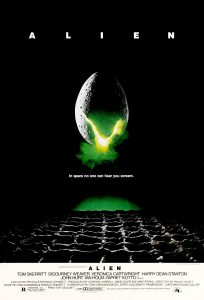Plot comes from story.
Post that on the wall.
Many writers don’t even know the difference between plot and story, even more rely on plot to engage their readers. The latter is a sure-fire way to make a mess of things. And not a hot sexy mess, but a dirty, smelly mess that nobody wants to sit next to on the downtown express.
Judgement time, rookie!
Plot is the roof on the house. If you don’t develop the story fundamentals and a sound structure, your roof has nothing supporting it… and it’s almost always guaranteed to collapse in a big way.
 Here’s how you do it, the abbreviated version.
Here’s how you do it, the abbreviated version.
I’ll use the 79 movie Alien cause I like it. Obviously, I didn’t write it, so I’m taking creative license here, but the process is on point;
1) Master Theme:
“Humanity may be the apex predator on Earth, but in space, predator becomes prey.”
Your core message to the reader.
Not having a Master Theme is like building your house in a flood zone, on mounds of sand instead of concrete piers.
2) Skeletal Outline:
Opening hook: A deep space hauler with a small crew gets rerouted to investigate an unknown signal.
Inciting incident: The signal comes from a crashed alien ship on an unexplored planet.
First Act Turn: A xenomorph gets onto the ship.
Painting the core movements of the story with broad strokes. You’re not looking for script level details. You want core ideas, to plot the overall progression of the story.
If you can’t see clearly where you’re going, you’ll never get there. Or to stick with the house analogy, if you build a house blindfolded, you’re not gonna have a straight angle in the whole house.
3) Comprehensive Outline:
The 7 crew members of the deep space hauling vessel, Nostromo, come out of hypersleep way ahead of schedule. To their surprise, company orders demand the group reroute to investigate an unknown signal from an unexplored moon, LV-426.
When the crew lands to investigate, their search party encounters a massive, crashed alien space craft. Entering the craft, the executive officer Kane accidentally gets a facehugger alien attached to his face. Unable to remove the creature, the search party rushes Kane back to their ship, where Ash lets them aboard.
The alien creature proves impossible to remove without killing Kane. Captain Dallas decides to leave Kane in the infirmary as they make their way back to Earth.
Here’s where you begin laying the plot level details.
The details are important, but the details pad out the bones of the story you’ve carefully and deliberately laid.
4) Script:
Excerpt Alien script, Walter Hill & David Giler;
INT. HYPERSLEEP VAULT
Explosion of escaping gas.
The lid on a freezer pops open.
Slowly, groggily, KANE sits up.
Pale.
Kane rubs the sleep from his eyes.
Stands.
Looks around.
Stretches.
Looks at the other freezer compartments.
Scratches.
Moves off.
INT. GALLEY
Kane plugs in a Silex.
Lights a cigarette.
Coughs.
Grinds some coffee beans.
Runs some water through.
KANE
Rise and shine, Lambert.
INT. HYPERSLEEP VAULT
Another lid pops open.
A young woman sits up.
LAMBERT
What time is it.
KANE
(voice over)
What do you care.
Finally, at the script level, the roof goes on. All the plot details are expressed to their fullest.
The plot reflects the story fundamentals, not vice versa.
I reckon almost all writers get their stories in discombobulated bits and pieces. Some of the pieces may arrive as plot level, or script level details and scenes.
If you’re good, or experienced, or good and experienced, you can tear apart plot level details–reverse engineer them, find the core story fundamentals and rebuild the narrative.
There’s nothing wrong with this approach.
But if you develop the plot level stuff first and believe if you make it “good enough,” it will be “good enough” to engage and entertain your readers, you’re in for a rude awakening.
Plot always serves story, never the other way around. And genuine story is what keeps people turning pages or in their seat, not the plot.
Sure there’s a bit more to it than these 4 points. I discuss it all on this site and in Storycraft, but that’s the nut of it. ▪
About the Author —
Nick Macari is a full-time freelance story consultant, developmental editor and writer, working primarily in the independent gaming and comic markets. His first published comic appeared on shelves via Diamond in the late 90’s. Today you can find his comic work on comixology, amazon and in select stores around the U.S. Visit NickMacari.com for social media contacts and news on his latest releases.
